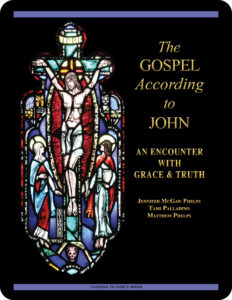 The Gospel According to John:
The Gospel According to John:
An Encounter with Grace & Truth
Lesson 10 This Woman Has Been Caught in Adultery
the Gospel According to John 8:1–11
Revised Standard Version Catholic Edition (RSVCE)*
New American Bible Revised Edition (NABRE)*
Catechism of the Catholic Church
ex libris (in our library)
glossary for the Gospel According to John
cross references in the Gospel According to John
next lesson: I Am the Light of the World
This material coordinates with Lesson 10 on pages 55–58 in The Gospel According to John: An Encounter with Grace & Truth.
“Now Jesus did many other signs in the presence of the disciples, which are not written in this book; but these are written that you may believe that Jesus is the Christ, the Son of God, and that believing you may have life in his name.”—the Gospel According to John 20:30–31
welcome to our in-depth study of the Gospel According to John
We invite interested groups and individuals to check out the sample first lesson from this 25- lesson Turning to
lesson Turning to  God’s Word Catholic Bible study. These online study pages link to our free lesson videos, as well as to a glossary and cross references in the biblical text. Other study aids include maps, additional commentary, and prayers based on the primary Scripture in each lesson. The Gospel According to John: An Encounter with Grace & Truth has been granted an imprimatur and can be purchased from our website shop. If you have a Bible-study question or comment, click on one of the “ask us your question” or “what do you think” buttons on any online study page.
God’s Word Catholic Bible study. These online study pages link to our free lesson videos, as well as to a glossary and cross references in the biblical text. Other study aids include maps, additional commentary, and prayers based on the primary Scripture in each lesson. The Gospel According to John: An Encounter with Grace & Truth has been granted an imprimatur and can be purchased from our website shop. If you have a Bible-study question or comment, click on one of the “ask us your question” or “what do you think” buttons on any online study page.
open with prayer
It’s always wise to begin any Bible study with prayer, whether reading the Scriptures alone or meeting with others in a discussion study group. You can pray using your own words or use one of the opening prayers on our website. We especially like the following:
Lord Jesus, you promised to send your Holy Spirit
to teach us all things.
As we read and study your word today,
allow it to touch our hearts and change our lives. Amen.
let’s review—the Gospel According to John 7:1–53
In Lesson 9 Rivers of Living Water, Jesus’ famous Bread of Life discourse is followed by a new discussion about what present-day readers know to be the sacrament of Baptism. Jesus quietly goes to Jerusalem alone for the feast of Tabernacles, one of the major feasts that Jews were required to celebrate in that city. Several days into the feast, Jesus goes into the Temple where his teaching attracts much attention—both favorable and unfavorable. On the eighth and final day of the feast, Jesus veers from his usual practice of speaking to single individuals in order to stand up and address the crowds in the city for the feast. His message concerns the same living water he spoke about to the Samaritan woman, but this time he says that from the hearts of those who have faith in him will flow rivers of living water. The Pharisees seek to arrest Jesus, but the officers they send are unwilling to do so once they hear Jesus speak. Nicodemus, one of the Pharisees, argues that Jesus shouldn’t be judged without a hearing, but the other Pharisees mock him and dismiss his concerns.
map notes—Jesus still is in Jerusalem
The end of the seventh chapter in the Gospel According to John found Jesus in Jerusalem for the feast 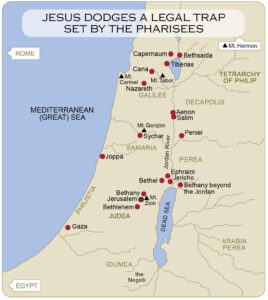 of Tabernacles, where his presence caused a sensation. His popularity landed him in hot water with the Jewish leaders, who were unsuccessful in attempting to arrest him. Events in the eighth chapter in the Gospel According to John follow closely on the heels of Jesus’ most recent antagonistic encounter with the Jews. Jerusalem—God’s Holy City—remains a dangerous location for God’s only-begotten Son, and the religious leaders—who should be expected to want to welcome any legitimate prophet from God—remain Jesus’ enemies. The religious leaders now attempt to escalate the conflict to involve the Roman authorities. Click on the image (right) to enlarge the map, which appears on page 57 in The Gospel According to John: An Encounter with Grace & Truth.
of Tabernacles, where his presence caused a sensation. His popularity landed him in hot water with the Jewish leaders, who were unsuccessful in attempting to arrest him. Events in the eighth chapter in the Gospel According to John follow closely on the heels of Jesus’ most recent antagonistic encounter with the Jews. Jerusalem—God’s Holy City—remains a dangerous location for God’s only-begotten Son, and the religious leaders—who should be expected to want to welcome any legitimate prophet from God—remain Jesus’ enemies. The religious leaders now attempt to escalate the conflict to involve the Roman authorities. Click on the image (right) to enlarge the map, which appears on page 57 in The Gospel According to John: An Encounter with Grace & Truth.
 Jesus bent down & wrote on the ground (24:20)
Jesus bent down & wrote on the ground (24:20)
Much commentary by many different Christian authors has been devoted to speculation about what it was that Jesus was  writing on the ground in the Gospel According to John 8:6. Although the Evangelist John didn’t record what Jesus wrote, human curiosity makes it difficult for present-day men and women not to wonder about it. In the video for this lesson, Turning to God’s Word author Matthew Phelps suggests the importance of Jesus’ act lies not so much in what was being written but in the dramatic value of Jesus’ action as a tactic to focus attention on what Jesus says when
writing on the ground in the Gospel According to John 8:6. Although the Evangelist John didn’t record what Jesus wrote, human curiosity makes it difficult for present-day men and women not to wonder about it. In the video for this lesson, Turning to God’s Word author Matthew Phelps suggests the importance of Jesus’ act lies not so much in what was being written but in the dramatic value of Jesus’ action as a tactic to focus attention on what Jesus says when  he finally speaks. For more information, you can read “What Did Jesus Write?” on page 57 in The Gospel According to John: An Encounter with Grace & Truth.
he finally speaks. For more information, you can read “What Did Jesus Write?” on page 57 in The Gospel According to John: An Encounter with Grace & Truth.
The Scripture ranges for the videos that accompany this Catholic Bible study match the Scripture ranges for the sets of questions in The Gospel According to John: An Encounter with Grace & Truth. You can follow along as Turning to God’s Word author Matthew Phelps discusses Lesson 10, “This Woman Has Been Caught in Adultery,” on pages 55–58 in the study book.
WHAT DO YOU THINK that Jesus was writing?
The biblical text provides few clues about what Jesus wrote, but we know it was powerful enough to cause the scribes and Pharisees to abandon the scene. We suspect—because this entire passage has to do with legality—that Jesus might have been writing something to do with the law. The very act of writing is closely aligned with the law since it’s through their skills as writers that the scribes developed their expertise in religious law.
 ? What is the Old Testament connection between law and writing? If necessary, refer to the book of Exodus 31:18.
? What is the Old Testament connection between law and writing? If necessary, refer to the book of Exodus 31:18.
? Consider how it is that all Jewish law at the time of Jesus was religious and not secular in nature.
? What might explain why the Evangelist John apparently didn’t consider what Jesus wrote significant enough to merit inclusion in this section in the Fourth Gospel?
? What might this imply about the Evangelist’s purpose in writing the Gospel According to John?
? Although we can’t know what Jesus wrote on the ground, we can speculate—provided we keep in mind that our ideas are just that, pure speculation. What thoughts do you have about what it is that Jesus might have written? (**Check the footnote to see one rather flippant idea suggested by Turning to God’s Word author Matthew Phelps.)
our shortest biblical text
Although Lesson 10 covers only the first eleven verses in the eighth chapter of the Gospel According to John, the biblical text raises a number of questions at the same time that it introduces some important ideas about Christianity.
 the popes inspire us—Jesus as divine legislator
the popes inspire us—Jesus as divine legislator
In “Divine Legislator,” the papal quote on page 57 in The Gospel According to John: An Encounter with Grace & Truth, Pope Benedict XVI reflects on the biblical text on which this lesson is based. He repeats St. Augustine’s thoughts about what Jesus might have been writing on the ground with his finger. A key to the view shared by Pope Benedict XVI and St. Augustine is the understanding of Jesus as Justice in person, an idea that emphasizes Jesus’ relationship to the law.
a connection to the prophet Jeremiah
Some scholars see a foreshadowing of the Gospel According to John 8:6 in the Book of Jeremiah 17:13: “O LORD, the hope of Israel, all who forsake you shall be put to shame; those who turn away from you shall be written in the earth, for they have forsaken the LORD, the fountain of living water.”
another Old Testament connection
A reader from California has pointed out that the account of Jesus writing on the ground with his finger recorded in the Gospel According to John 8:6 is reminiscent of the writing on the wall in the fifth chapter of the Book of Daniel. That Old Testament passage describes a disembodied hand writing on the wall of the room in which the Babylonian king Belshazzar and his guests were drinking wine out of sacred vessels looted from the Temple in Jerusalem. The prophet Daniel is sent for to interpret the writing, and he announces it is a condemnation of Belshazzar, who has failed to honor the God responsible for his very life. This and the account in the book of Exodus 31:18 both describe instances of God inscribing messages related to the way in which human beings are expected to behave. Learn more about the apocalyptic writings of the prophet Daniel in Lesson 18 Daniel: A Model Jew and  Lesson 19 Old Testament Eschatology, both in the Turning to God’s Word Catholic Bible study Thus Says the LORD: God Speaks Through His Servants the Prophets—Volume II: Restoration & Redemption.
Lesson 19 Old Testament Eschatology, both in the Turning to God’s Word Catholic Bible study Thus Says the LORD: God Speaks Through His Servants the Prophets—Volume II: Restoration & Redemption.
casting the first stone
The book of Deuteronomy 17:7 provides additional insight into what Jesus says to the scribes and Pharisees in the Gospel According to John 8:7.
who’s the woman caught in adultery?
Although this woman frequently is portrayed in religious art as Mary Magdalene, this is speculation. 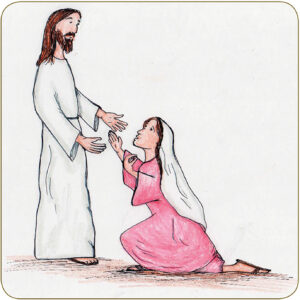 Nothing in the biblical text suggests that this is indeed the case—though it’s of course a possibility. There are many misconceptions about things commonly believed to be scriptural. For instance, most people are of the opinion that Eve was tempted to eat an apple from the tree of the knowledge of good and evil, but the text in the third chapter in the book of Genesis doesn’t specify what kind of fruit was on the tree. It may have been an apple, or it may have been a pear, or a date, or a pomegranate—or it may have been some type of fruit completely unknown to us. It doesn’t seem terribly important that we know the exact type of fruit involved in the fall of Adam and Eve, and an apple serves the artistic purpose of visualizing the scene. You can learn more in Lesson 3 The Fall of Adam & Eve
Nothing in the biblical text suggests that this is indeed the case—though it’s of course a possibility. There are many misconceptions about things commonly believed to be scriptural. For instance, most people are of the opinion that Eve was tempted to eat an apple from the tree of the knowledge of good and evil, but the text in the third chapter in the book of Genesis doesn’t specify what kind of fruit was on the tree. It may have been an apple, or it may have been a pear, or a date, or a pomegranate—or it may have been some type of fruit completely unknown to us. It doesn’t seem terribly important that we know the exact type of fruit involved in the fall of Adam and Eve, and an apple serves the artistic purpose of visualizing the scene. You can learn more in Lesson 3 The Fall of Adam & Eve  in the Turning to God’s Word Catholic Bible study In the Beginning: The Book of Genesis. (Tami Palladino’s illustration of Jesus and the woman taken in adultery appears on the map, “Key Events in the Gospel According to John,” on page 146 of the study book.)
in the Turning to God’s Word Catholic Bible study In the Beginning: The Book of Genesis. (Tami Palladino’s illustration of Jesus and the woman taken in adultery appears on the map, “Key Events in the Gospel According to John,” on page 146 of the study book.)
guessing about Scripture can be dangerous
To guess at the identity of the woman caught in adultery, however, is a somewhat more serious matter. A large number of paintings, works of fiction, films, and speculative documentaries portray the woman as Mary Magdalene. It’s important to remember that this idea isn’t supported by Scripture. It’s equally important to remember that many other things sometimes suggested in non-biblical writings and films about Mary Magdalene and her relationship to Jesus also aren’t supported by Scripture.
Because the Evangelist John isn’t shy about naming Mary Magdalene later (in the Gospel According to John 20:1), it seems odd that he’d have chosen not to identify her in the first eleven verses of the eighth chapter if she and the woman caught in adultery are the same person. It appears likely that the Evangelist intentionally may have withheld the name of the woman caught in adultery because she represents something more than might be understood if we were to take this account from Jesus’ life at face value. In the final analysis, it’s impossible for us to know whether this woman is or isn’t Mary Magdalene, so the safest approach is to stay tethered to the biblical text and not to assume anything about her that the Evangelist doesn’t tell us.
WHAT DOES SCRIPTURE TELL US about this woman?
Some scholars see a connection between the woman caught in adultery and other women in the Fourth Gospel.
 ? How does Jesus address the woman caught in adultery?
? How does Jesus address the woman caught in adultery?
? Who else in the Gospel According to John has Jesus addressed in the same way?
? How is this woman related to the others who’ve been addressed in a similar fashion by Jesus?
? What does this suggest about the role that this unnamed woman might play in this section in the Fourth Gospel?
WHAT DO YOU THINK about the continuing nuptial theme?
Throughout the Fourth Gospel, the Evangelist uses marriage as an image of the union of human and divine in the person of Jesus Christ. The clue to this reference in the eighth chapter is hidden in the religious laws that the scribes and Pharisees rely on when they bring the woman as a way of testing Jesus. Find the relevant laws in the book of Leviticus 20:10 and the book of Deuteronomy 22:23–24.
 ? What in those laws suggests that these first verses in the eighth chapter in the Gospel According to John have something to do with betrothal or marriage?
? What in those laws suggests that these first verses in the eighth chapter in the Gospel According to John have something to do with betrothal or marriage?
? What key characters mentioned in the law are absent in this account of the New Testament event?
? What might explain why that is?
 Lord—you could look it up in our archives
Lord—you could look it up in our archives
The Greek word kyrios can be translated several ways that modify the meaning in the Gospel According to John. To learn how this translation issue affects use of the word “lord,” read Lost in Translation, an online column in which Turning to God’s Word author Matthew Phelps helps readers connect with ideas expressed in the original languages of the Scriptures. New Lost in Translation entries are posted on Mondays, and past entries are archived on our website. Contact us if you’d like to receive Lost in Translation by email every week.
biblical factoid
The woman caught in adultery appears only in the first eleven verses of the eighth chapter in the Fourth Gospel. Although some scholars debate the inclusion of this story in Scripture, this isn’t a topic that’s open for discussion among Catholics. To learn when and where the Church definitively settled this issue, read “Where Do These Verses Belong?” on page 56 in The Gospel According to John: An Encounter with Grace & Truth.
for additional reflection
Because many of the details in the account of the woman taken in adultery are so interesting, it can be easy to overlook one of the main points about Jesus that the Evangelist is emphasizing. The following questions are designed to help readers begin to form their own thoughts and ideas related to the Gospel According to John 8:1–11. For more reflection questions, refer to the introduction to this lesson on page 55 in The Gospel According to John: An Encounter with Grace & Truth.
 ? Jesus’ words from the Gospel According to John 8:7 frequently are quoted with emphasis placed on who’s without sin. What in Jesus’ statement might be seen as being even more relevant?
? Jesus’ words from the Gospel According to John 8:7 frequently are quoted with emphasis placed on who’s without sin. What in Jesus’ statement might be seen as being even more relevant?
? According to Jesus, what does a person without sin have the authority to do?
? What in the biblical text suggests that the scribes and Pharisees accept Jesus’ premise?
? What does it mean to condemn someone?
? What’s significant about the fact that none of the scribes or Pharisees have condemned the woman?
? Consider why Jesus refuses to condemn the woman.
? What message that might send to present-day Christians?
? In the Gospel According to John 8:11, Jesus’ words suggest that the woman is indeed guilty of sin. What might her situation represent?
? Consider how Jesus’ refusal to condemn the woman might reflect the reason that he’s come down from heaven.
the best Catholic commentary about Scripture
To find out more about how Church teaching is supported by Scripture passages in The Gospel According to John: An Encounter with Grace & Truth, check out the Index of Citations in the Catechism of the Catholic Church. Links (Revised Standard Version Catholic Edition [RSVCE*]) to the primary Scripture passages in the lesson and relevant paragraphs in the Catechism are provided here. Not every passage in the biblical text for this study is referenced in a Catechism paragraph, however.
the Gospel According to John 8:2—paragraph 583
ways our glossary might prove helpful
In addition to providing extra information about geographical locations, our glossary also points out  persons and places mentioned in the biblical text under multiple names or spellings. If you can remember a name but aren’t sure in which lesson it shows up, you can find it in the glossary, which lists every proper noun that appears in the primary biblical text for The Gospel According to John: An Encounter with Grace & Truth.
persons and places mentioned in the biblical text under multiple names or spellings. If you can remember a name but aren’t sure in which lesson it shows up, you can find it in the glossary, which lists every proper noun that appears in the primary biblical text for The Gospel According to John: An Encounter with Grace & Truth.
to learn more, read more Scripture
If you’re having difficulty with a passage of Scripture, it can be helpful to read the relevant  cross references—but looking these up can take time. To make that easier, we’ve compiled the cross references from the Revised Standard Version Second Catholic Edition (RSV2CE)—the translation that we reprint in our study books. That list can be found at the top of every online study page accompanying this study, and it includes links to each of the cross references in the primary biblical text for The Gospel According to John: An Encounter with Grace & Truth.
cross references—but looking these up can take time. To make that easier, we’ve compiled the cross references from the Revised Standard Version Second Catholic Edition (RSV2CE)—the translation that we reprint in our study books. That list can be found at the top of every online study page accompanying this study, and it includes links to each of the cross references in the primary biblical text for The Gospel According to John: An Encounter with Grace & Truth.
… but remember that the cross references aren’t canonical
Unfortunately, the editors of the Revised Standard Version who compiled the cross references for the section of Scripture that’s the basis for this lesson—the Gospel According to John 8:1–11—didn’t include any cross references. Although there are a great many verses in Scripture that don’t have cross  references, and we choose not to second-guess the editors about their choices, it’s surprising that there aren’t any for these 11 verses. When reading Scripture, it’s important to remember that the cross references and footnotes aren’t canonical, that is, they don’t carry the same weight as the Scripture itself but reflect the thinking of the editors responsible for compiling the translation. That means that the Church doesn’t consider cross references, footnotes, and commentary in study Bibles as necessarily inspired by the Holy Spirit, who’s considered the divine author of Scripture. The Scripture verses that are cited in the cross references are canonical, but the choice of what to cite isn’t.
references, and we choose not to second-guess the editors about their choices, it’s surprising that there aren’t any for these 11 verses. When reading Scripture, it’s important to remember that the cross references and footnotes aren’t canonical, that is, they don’t carry the same weight as the Scripture itself but reflect the thinking of the editors responsible for compiling the translation. That means that the Church doesn’t consider cross references, footnotes, and commentary in study Bibles as necessarily inspired by the Holy Spirit, who’s considered the divine author of Scripture. The Scripture verses that are cited in the cross references are canonical, but the choice of what to cite isn’t.
? What verse or verses might be obvious choices to cross reference the Gospel According to John 8:1–11?
? What might explain why there are no cross references in this section? If necessary, read “Where Do These Verses Belong?” on page 56 of The Gospel According to John: An Encounter with Grace & Truth. This short commentary offers one possible clue. There might be other reasons.
? Consider whether it’s likely that the editors of the RSV translations were correct when they chose not to include any cross references related to the woman taken in adultery.
? What questions do you have about the biblical text for this lesson that might be clarified by citations of other verses in Scripture?
don’t forget about our indexes & extra online material

 If you’re trying to locate information about a specific Scripture passage, you can look it up in the index at the back of the study book or sample lesson. If you want to find a particular commentary, you can look up its title in the topics index. To learn more about another book of the Bible for which there’s a Turning to God’s Word study, visit the online study directories to read the commentaries and watch any accompanying videos. Finally, if you have a question or would like to make a comment about any of our studies, you can use one of the “ask us your question” or “what do you think” buttons to email our authors.
If you’re trying to locate information about a specific Scripture passage, you can look it up in the index at the back of the study book or sample lesson. If you want to find a particular commentary, you can look up its title in the topics index. To learn more about another book of the Bible for which there’s a Turning to God’s Word study, visit the online study directories to read the commentaries and watch any accompanying videos. Finally, if you have a question or would like to make a comment about any of our studies, you can use one of the “ask us your question” or “what do you think” buttons to email our authors.
ex libris—Church documents & books about religious topics
You can find links to magisterial documents referred to in Turning to God’s Word Catholic Bible studies  at ex libris—magisterial documents. This page includes a listing of significant recent encyclicals as well as a number of historical Church documents. Recommended books related to Scripture study can be found at ex libris—main bookshelf.
at ex libris—magisterial documents. This page includes a listing of significant recent encyclicals as well as a number of historical Church documents. Recommended books related to Scripture study can be found at ex libris—main bookshelf.
wondering how to pronounce some of these words?
The following link is to a reading from the New International Version (NIV) Bible. To listen, click on the audio icon above the printed text. Although not taken from the translations used in our study materials, the NIV reading provides an audio guide to pronunciation of words in this lesson’s primary biblical text. A close online version of the translation of the Bible used in Catholic liturgy in the United States as well as an audio guide for daily Mass readings for the current month can be found on the website of the United States Conference of Catholic Bishops (USCCB).
the Gospel According to John 8:1–11 (NIV)
 close with Bible-based prayer related to this lesson
close with Bible-based prayer related to this lesson
Many of our Catholic study groups like to conclude their discussions with a prayer based on the scriptural focus of their lesson, and some participants include Scripture-specific prayer in their individual study. If you’re uncomfortable composing your own Bible-based prayers, you can follow our four easy steps, or you can use the following prayer based on this lesson’s text from the Gospel According to John.
God our Father, you are the source of all goodness.
Help us to remain aware of our own failings
and enable us to show others the same compassion
that Jesus showed to the woman caught in adultery.
We ask this in the name of Jesus Christ. Amen.
Lesson 11 I Am the Light of the World—the Gospel According to John 8:12–59
Lesson 9 Rivers of Living Water—the Gospel According to John 7:1–53
you also may like our two-part study of the prophets
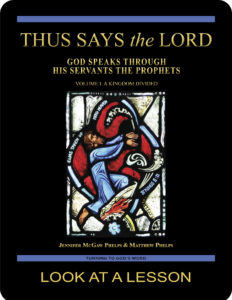
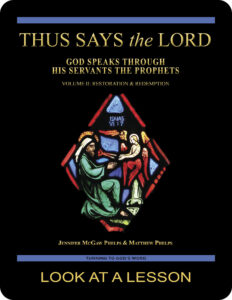 Thus Says the LORD: God Speaks Through His Servants the Prophets—Volume I: A Kingdom Divided examines the prophets in their historical context using the First and Second Books of the Kings and other Old Testament passages written before the Babylonian Exile in 586 B.C. Volume II: Restoration & Redemption looks at the post-exilic prophets. This 51-lesson Catholic Bible study builds on The United Kingdom of Israel: Saul, David & Solomon Foreshadow Christ the King. Click on the books’ covers to view a sample lesson from each volume.
Thus Says the LORD: God Speaks Through His Servants the Prophets—Volume I: A Kingdom Divided examines the prophets in their historical context using the First and Second Books of the Kings and other Old Testament passages written before the Babylonian Exile in 586 B.C. Volume II: Restoration & Redemption looks at the post-exilic prophets. This 51-lesson Catholic Bible study builds on The United Kingdom of Israel: Saul, David & Solomon Foreshadow Christ the King. Click on the books’ covers to view a sample lesson from each volume.
start a Turning to God’s Word Bible study
 Thank you for your interest in The Gospel According to John: An Encounter with Grace & Truth.
Thank you for your interest in The Gospel According to John: An Encounter with Grace & Truth.  Information about beginning a Turning to God’s Word Bible study can be found at start a Bible study. Tami, Matthew, and I are available to answer questions and offer support. Contact us if you’d like to start one of our studies or have your schedule listed with other TtGW study groups on our website. —Jennifer
Information about beginning a Turning to God’s Word Bible study can be found at start a Bible study. Tami, Matthew, and I are available to answer questions and offer support. Contact us if you’d like to start one of our studies or have your schedule listed with other TtGW study groups on our website. —Jennifer
*There are seven deuterocanonical books in the Old Testament—the Books of Tobit, Judith, Wisdom, Sirach, Baruch, and First and Second Maccabees, as well as some passages in the Books of Esther and Daniel. Protestants usually refer to these works as “apocryphal,” a word that means “outside the (Protestant) canon” because they’re excluded from most Protestant Bibles. The word “deuterocanonical” means “second canon”; Catholics use that word to refer to any section of the Catholic Old Testament for which there are no extant, or existing, Hebrew manuscripts. All of the deuterocanonical books appear in the Septuagint, the earliest remaining versions of which date to the 1st century B.C. This Greek translation of the Old Testament was in common use by Jews at the time of Jesus—but the same books aren’t found in existing Hebrew manuscripts, which aren’t as old as the oldest version of the Septuagint. Learn more by reading How Do Catholic & Protestant Bibles Differ?
Turning to God’s Word printed Bible studies use the 2006 Revised Standard Version Second Catholic Edition (RSV2CE) translation for all Scripture references except those to the Psalms, which are taken from The Abbey Psalms and Canticles, prepared by the Benedictine monks of Conception Abbey and published in 2020 by the United States Conference of Catholic Bishops (USCCB). All Scripture links for the online study pages for The Gospel According to John: An Encounter with Grace & Truth are to the 1966 Revised Standard Version Catholic Edition (RSVCE) translation. The New International Version (NIV) audio recordings follow the same chapter and verse numbering as the RSV Catholic translations, but the NIV translation doesn’t include the deuterocanonical books and passages.
The 1966 RSVCE uses archaic pronouns and verb forms such as “thee,” “thou,” “didst” in the Psalms and in direct quotations attributed to God. The 2006 RSV2CE replaces those with more accessible English. The few significant translation changes in the RSV2CE include rendering almah as “virgin” in the Book of Isaiah 7:14 and restoring the term “begotten” in the Gospel According to John 3:16.
Numbering varies for some passages in this Bible study. Turning to God’s Word studies (print and digital) follow the numbering in the Revised Standard Version Catholic translations (RSV2CE and RSVCE). Discrepancies in the New American Bible Revised Edition (NABRE) are noted in the Index of Scripture Citations in the study book and the online sample.
 You can learn more about the Psalms by viewing a sample lesson from the Turning to God’s Word Catholic Bible study Sing a New Psalm: Communicating with God Through the Prayers of the Church—Volume I: Lauds & Vespers. The second part of that study, Sing a New Psalm: Communicating with God Through the Prayers of the Church—Volume II: Vigils, Day Prayer & Compline, is scheduled for publication in 2025. Some verse numbers may vary in different translations of the Psalms.
You can learn more about the Psalms by viewing a sample lesson from the Turning to God’s Word Catholic Bible study Sing a New Psalm: Communicating with God Through the Prayers of the Church—Volume I: Lauds & Vespers. The second part of that study, Sing a New Psalm: Communicating with God Through the Prayers of the Church—Volume II: Vigils, Day Prayer & Compline, is scheduled for publication in 2025. Some verse numbers may vary in different translations of the Psalms.
 **from the sublime to the ridiculous
**from the sublime to the ridiculous
Click on Turning to God’s Word author Matthew Phelps’ photo (right) to see his depiction of one of the many possible things that Jesus might have been tracing on the ground with his finger in the Gospel According to John 8:6. While Matthew”s drawing appears trivial, it’s based on the idea that what Jesus was writing might be of far less importance than that Jesus intentionally was taking his time responding to the trap set for him by scribes and Pharisees.
